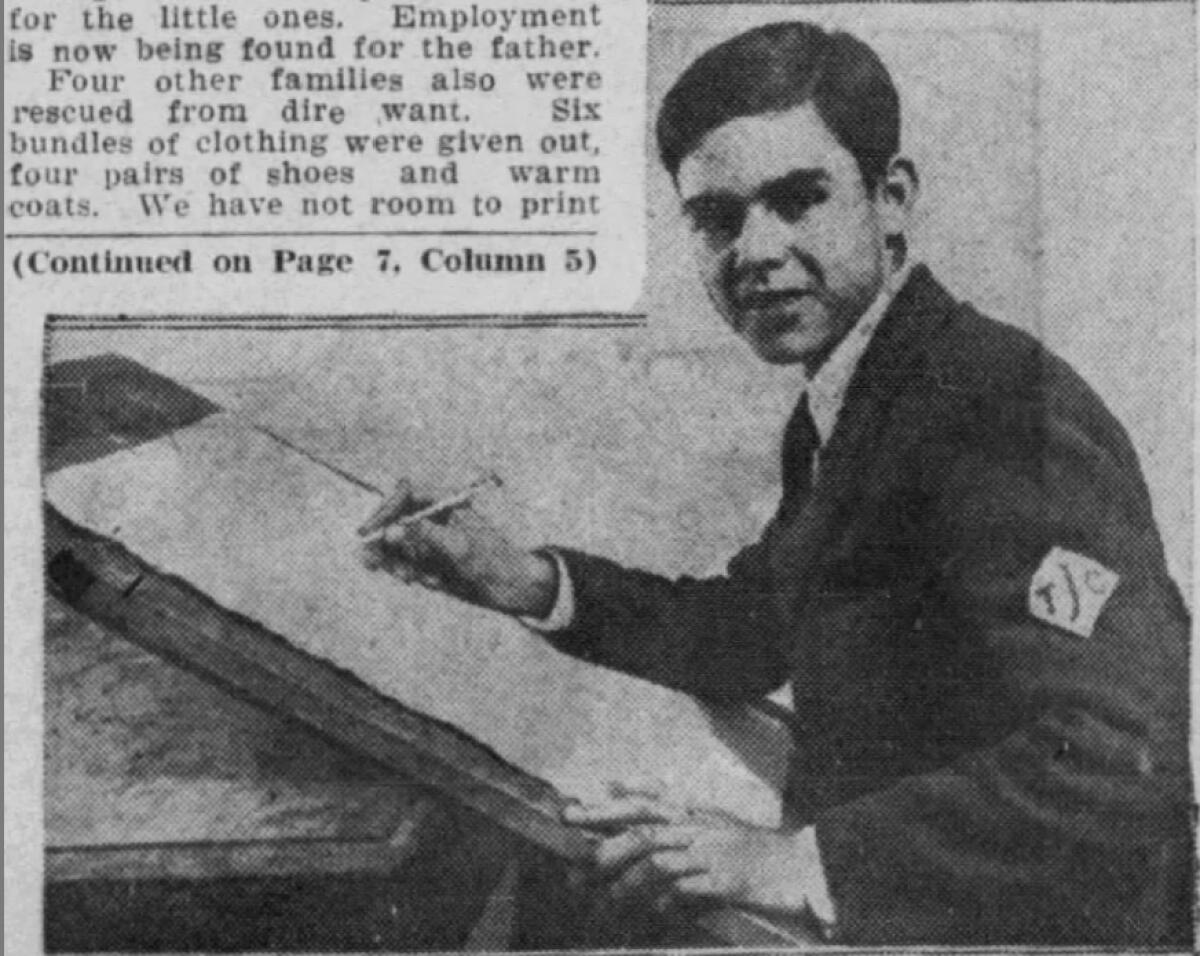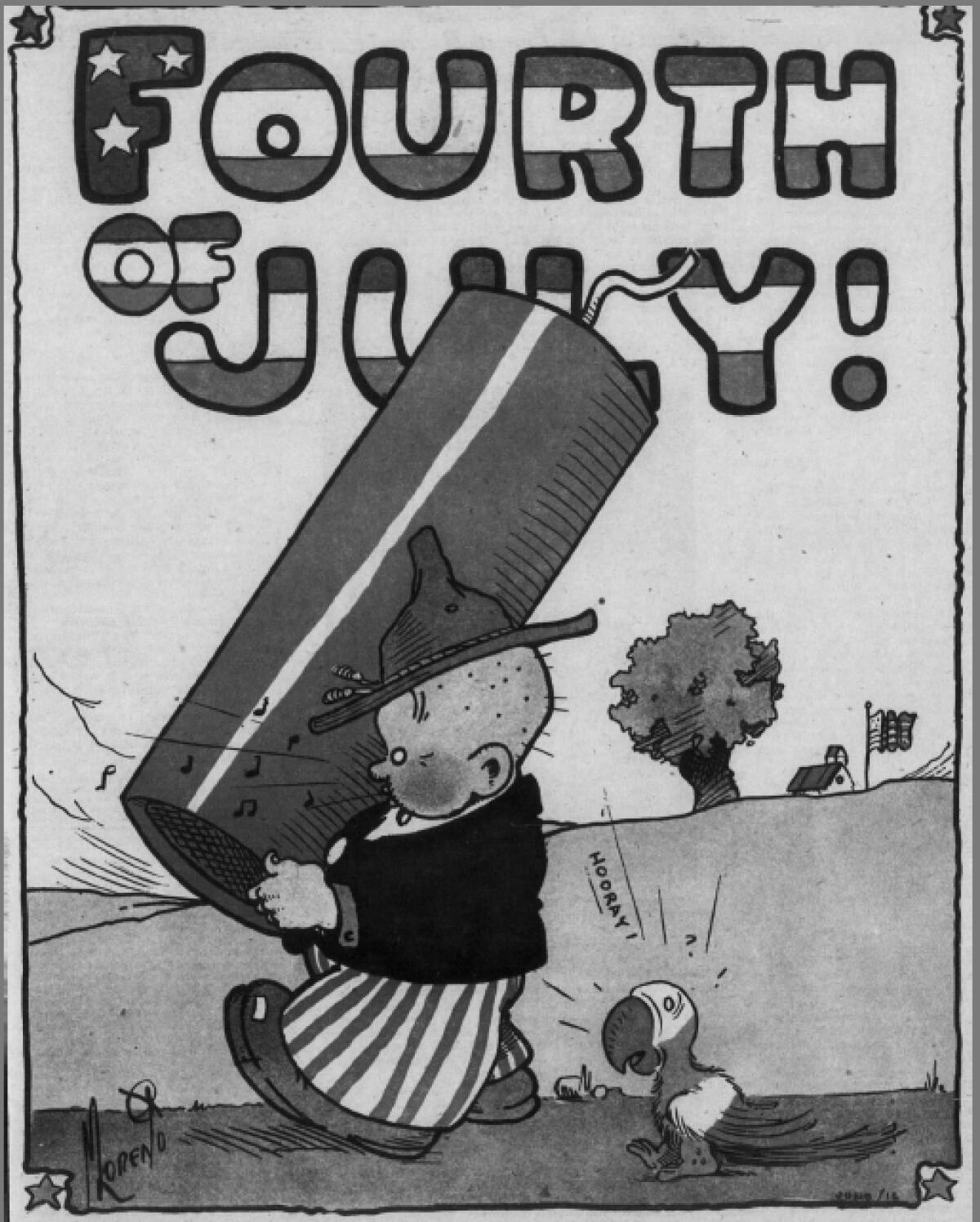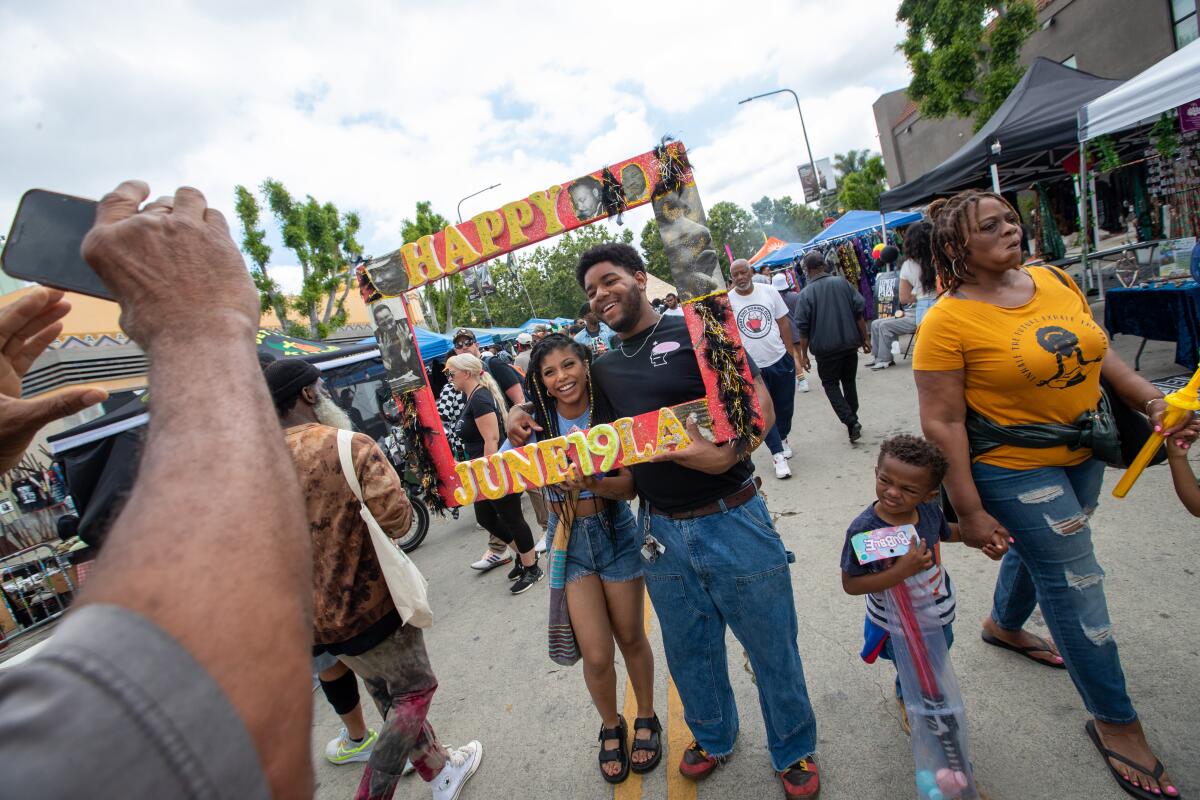Manuel M. Moreno, the Times teen cartoonist turned pioneering animator

- Share via
Good morning, and welcome to the Essential California newsletter. It’s Wednesday, June 28. I’m Gustavo Arellano, reporting from Orange County. I’m a columnist, which means I’m allowed to have opinions. Like:
Animation is cool.
My late mami always said that I learned English as quickly as I did by watching classic cartoons: Mickey Mouse, Tom & Jerry, Bugs Bunny, Woody Woodpecker, Mighty Mouse and so many more. As a teen through my early 20s, my favorite shows were FOX must-sees “The Simpsons,” “King of the Hill” and “Futurama.” My adult years brought on “South Park,” “SpongeBob SquarePants” and most anything on Cartoon Network, and the streaming era has been all about “BoJack Horseman” and “Tuca & Bertie.”
From early on, I noticed something interesting: a lot of Hispanic surnames in the credits.
While Old Hollywood stereotyped Latinos or just ignored them (still does, alas), animation was a space where Latinos — particularly Mexican Americans — were able to flourish. Some became legends like Bill Melendez (who brought “Peanuts” to television), Phil Roman (whose animation studio long produced “The Simpsons”) and Disney stalwart X Atencio; others might not get as much mainstream attention but are nevertheless respected by animation buffs.
In the latter group is Manuel M. Moreno.
He was a trusted supervisor for Walter Lantz in the 1930s, and also worked for MGM. Disney animators who had worked with Moreno tried multiple times to recruit him to the Mouse House, but he instead took over his brother’s camera shop during World War II, then moved to his native Mexico to run an animation studio. Moreno returned to L.A. in the 1950s, left the world of cartoons, and ran a successful photo-processing store for decades.
Loyola Marymount animation professor Tom Klein is working on a biography of Moreno, whom he called “a figure who really deserved more and could’ve been so much more.” He plans to tell the history of animation in Los Angeles through his book, and has been in the proverbial salt mines for years. That’s how he found out that Moreno was probably the first Latino to pen his own regular comic strip in a major American newspaper, from 1924-26.
The paper? The Los Angeles Times.
Moreno did this as a teenager.
What did you do in high school?
“Despite the racism of the time, there’s also a moment where everyone thinks they can get a piece of the American dream,” Klein told me. “And here’s this kid taking advantage of getting exposure in the L.A. Times, and he succeeds.”
Moreno’s relationship with this paper began 100 years ago this week, when the July 1, 1923, edition of the Junior Times (our children’s supplement) back then published three of his illustrations: a newsboy, two soldiers and a fisherman falling off his boat while pulling in a giant catch. Aunt Dolly, the pseudonym for the head of the Junior Times, praised the 13-year-old Moreno for having “never given up hope” of getting published.
“I can imagine the kind of man you’ll be, one of those fellows who make things come their way,” she wrote, “and believe that opportunity is manufactured of ourselves, not brought about by circumstance and chance.”
A year later, Moreno was writing and inking an occasional comic strip under the title “The Tuttlems,” the travails of a husband and wife. He also frequently illustrated the front page of the Junior Times, an honor that came with a $10 bonus — about $177 in today’s money. His big break, however, was with “Keen and Feeble Tat,” two brothers who constantly got into pickles and which the Times published weekly. By then, the paper already hailed him as “one of our most consistent winners of art prizes.”

“He looks like a child cartoonist when he first starts,” Klein said of Moreno, “but his level of talent accelerates so quickly that by the end of his run, he’s drawing at a professional level.” The professor praised the teen’s quick pivot to “continuity strips” — a story told over weeks — instead of one-off gags, citing a run where Keen and Feeble Tat fly to different countries.
“Manuel has not traveled the world, but he’s reading and illustrating it,” Klein added. “Already, you have the notion of a child who sees all the possibilities in the world, and he seems fearless.”
Moreno’s last illustration for the Times published in 1927, but he never abandoned the paper that gave him his break. “Manuel is now making a good salary, but has he forgotten us?” Aunt Dolly wondered that year. “Never has he missed a club art meeting, nor has he lost the gentleness and kindness that have always stamped him as a clean-cut sport.”
The following year, the Times reported that Moreno held a screening of some of his “animated funnies” to members of the Junior Times Club. By then, the 19-year-old already worked for animation studios. Moreno’s torch for Latino representation in the Times was being carried by another young Mexican immigrant: Alex Perez, who also started at the Junior Times before becoming a staff illustrator for the adult Times for 50 years.
Klein has authored articles on Moreno for the online publication Cartoon Research and stresses his career isn’t really a what-if, since Moreno found success. But the scholar still thinks Moreno should be better known, and feels that fame would’ve come he had joined Disney.
“Manuel would’ve been part of something that is celebrated around the world,” Klein said. “There’d probably be many books written about him. It’s like the talent that got away.”
And now, here’s what’s happening across California:
Note: Some of the sites we link to may limit the number of stories you can access without subscribing.
L.A. STORIES
Imelda Padilla takes early lead in L.A. City Council District 6 race. Padilla led rival Marisa Alcaraz in initial results Tuesday night in the special election for the Los Angeles City Council seat representing the northeast and central San Fernando Valley. Los Angeles Times

They saved a block of Leimert Park from gentrification. That was just the beginning. Black entrepreneurs, activists, residents and developers take a stand. Los Angeles Times
Héctor Tobar on “Our Migrant Souls: A Meditation on Race and the Meanings and Myths of ‘Latino’”. The former, longtime Times reporter/columnist/critic and current UC Irvine professor talks about his career and new book in the excellent podcast, “Writing Latinos.” Public Books
Getting schooled with a program for the commencement of Los Angeles High School, 21 June 1897. What was the Gilded Age’s version of a TikTok reel? The Homestead Blog
POLITICS AND GOVERNMENT
Takeaways from the California budget deal between Newsom and Democratic lawmakers. Gov. Gavin Newsom and Democratic legislative leaders on Monday agreed to a $310.8-billion budget spending plan that will reduce investments in fighting climate change and reflects a compromise on the governor’s last-minute proposal to speed up infrastructure projects across California. Los Angeles Times
California has tried to boost its housing stock. See which states have done better. Go ahead, Idaho and Utah: Take a victory lap around us. Just means more loquats for the rest of us. Los Angeles Times
CRIME, COURTS AND POLICING
A boxer opened a Pasadena gym to be ‘a safe space.’ It’s been robbed twice in two months. Where’s Gerry Cooney when we need him? Los Angeles Times
California’s collusion with a Texas timber company let ancient redwoods be clearcut. An excerpt from Siskiyou Land Conservancy president Greg King’s upcoming book on the Redwood Wars. History News Network
Support our journalism
HEALTH AND THE ENVIRONMENT
Solar sprawl is tearing up the Mojave Desert. Is there a better way? Our energy man (and long-suffering Dodgers fan) Sammy Roth on the beat. Los Angeles Times
What was that fireball blazing across the Southern California sky? Take your pick: UFO, comet, Captain Marvel or Goku. Los Angeles Times
‘This water needs to be protected’: California tribe calls for preservation of Tulare Lake. Better a natural body of water than a bunch of nut groves, you know? Los Angeles Times
Water Whiplash: Reliving history while kayaking through the San Joaquin Valley. From the resurrected Tulare Lake to the Sacramento-San Joaquin River delta — now, onward to Hetch Hetchy while it’s around! Valley Public Radio
CALIFORNIA CULTURE
Those loud popping noises you just heard — fireworks or gunshots? To paraphrase Louis Armstrong, if you have to ask, you’ll never know. The Oaklandside
Cup of Chisme: What to do with old libraries? Voice of San Diego managing editor Andrea Lopez-Villafaña’s weekly newsletter asks an important question. The answer? Call on Dr. Gene Scott, of course! Voice of San Diego
Keeping a watchful eye: A half-century of the Residents. The weirdest weirdos to ever weird up San Francisco, the avant-garde anonymous band makes Emperor Norton seem as rational as Descartes. Truthdig
Lake Tahoe has a staggering tourism problem, report shows. Lake Havasu says: Hold my Arrogant Bastard Ale. SFGATE
Free online games
Get our free daily crossword puzzle, sudoku, word search and arcade games in our new game center at latimes.com/games.
AND FINALLY
Today’s California landmark is from Jen Kanter, who nominates Santa Cruz Island in Channel Islands National Park.

Jen writes:
Since this island is protected as a national park and only accessible by boat, it’s full of largely untouched natural beauty. Marine life thrives all around the island, too.
What are California’s essential landmarks? Fill out this form to send us your photos of a special spot in California — natural or human-made. Tell us why it’s interesting and what makes it a symbol of life in the Golden State. Please be sure to include only photos taken directly by you. Your submission could be featured in a future edition of the newsletter.
Please let us know what we can do to make this newsletter more useful to you. Send comments to [email protected].
Sign up for Essential California
The most important California stories and recommendations in your inbox every morning.
You may occasionally receive promotional content from the Los Angeles Times.




